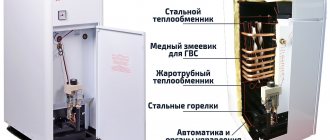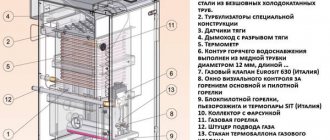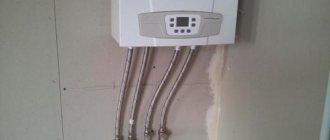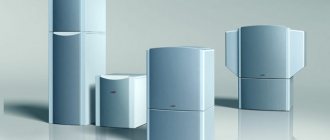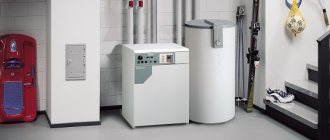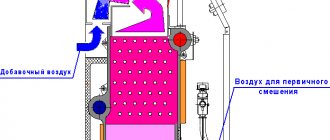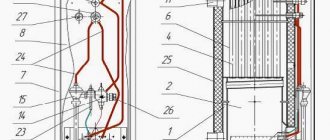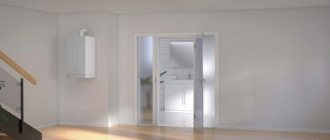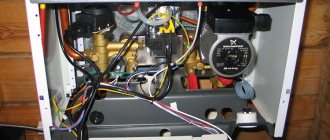Gas boilers are complex technical equipment that requires knowledge of proper operating instructions. Today's equipment has reduced the risks of emergency situations when using gas heaters, but they still occur. In this article we will talk about how to operate gas boilers wisely.
General instructions for use
Before you start using a gas boiler, you must connect it to the gas network, heating pipes, cold and hot water supply (if the unit is double-circuit and is also intended for preparing hot water), and electrical network, which must meet the technical characteristics of the machine.
Gas connections are made only by certified gas service workers. The water is connected and the boiler is started for the first time by representatives of a specialized organization for servicing heating systems. When connecting, strictly adhere to the requirements of the warranty card and operating instructions, otherwise the warranty will be void. A gas boiler can only be used for the purposes for which it is intended.
Table of the required boiler room volume depending on the boiler power.
The manufacturer is not responsible for improper operation of the boiler, violation of operating rules and for damage associated with this. This will also void the warranty.
Installation, service and other work must be carried out in full accordance with the regulatory and technical documentation and user manual. Only original spare parts must be used.
If a malfunction is detected in the operation and/or breakdown of the unit, you must immediately turn off the gas supply at the tap and call a qualified specialist. It is strictly prohibited to carry out any work on the gas boiler yourself.
When performing any work on or near air ducts and chimneys, it is necessary to turn off the device and turn off the gas. After completing the work, before turning on the boiler, you should check the functionality of the air ducts and chimneys.
When the gas boiler is turned off for a long time
- turn off the gas tap;
- when the boiler automation is powered from the mains and there is an electric water pump, disconnect them from the line;
- turn off the taps of the cold and hot water supply system, heating system;
- if the heating system is filled with water and the ambient temperature is expected to drop below 0°C, the water must be drained from the heating system;
- The final shutdown of the unit should be entrusted to a specialist.
When cleaning the boiler, turn it off. The device can be cleaned with damp cloth rags, a mild detergent, and soapy water. Do not use aggressive chemicals for cleaning, including detergents, insecticides, and other toxic substances.
The use and storage of flammable substances in the same room as a gas unit is strictly prohibited.
Specifications
Let's look at the technical characteristics of the installations:
| Parameter | Meaning |
| Thermal power range | 9-36 kW |
| Nominal thermal load | 26.7 kW-34.8 kW |
| Hot water consumption | 1.5-17.3 l/min |
| Fuel type | Natural or liquefied gas |
| Chimney type | Coaxial 60/100 mm |
| Dimensions | 800/440/338 mm |
| Power supply | 220 V 50 Hz |
| Gas pipeline connection size | 15 mm (R 3/4) |
| Heating connection dimensions | R 3/4 |
| Water pipes | R 3/4-R 1/2 |
Requirements for use
Before you start using the boiler, you need to make sure of some very important points. The heating system must have the right amount of fluid. The boiler itself must be connected to the atmosphere through an expansion tank. The safety valve and burner field must be in working order. The latter should be freed from foreign objects and other debris. The boiler valve must be opened.
Before starting ignition, it is necessary to remove the protective film, if any, from the burner. How is ignition carried out? First you need to make sure that there is no smell of gas in the room. In addition, such phenomena as an open pipeline supply valve and the presence of draft in the chimney are unacceptable. Immediately before ignition, the burner viewing window opens. The burners bring fire to the middle of the field. If ignition has occurred, a slight pop should appear. As a rule, this happens within 5-7 seconds.
If, after these steps, ignition still does not occur, then you should immediately turn off the valve and ventilate the room. The next attempt can be made no earlier than 10 minutes later. This is what the operating rules say.
The temperature during boiler operation must not fall below 65°C, as this may lead to condensation.
It is important to ensure that no specific gas odor arises in the room during work. At the same time, the temperature cannot be higher than 90°C
The boiler burner must be periodically cleaned of dirt.
This is what the basic operating instructions for this unit look like. It is important to be careful when using a gas boiler and not to deviate from the rules of use. Use it correctly!
Dangerous situations
The greatest danger is a malfunction associated with the operation of the burners. If the flame goes out, gas may accumulate in the room, which will subsequently cause an explosion. Reasons for the fire going out:
- gas pressure has dropped below the permissible norm;
- no draft in the chimney;
- the supply voltage has disappeared;
- The pilot light went out.
In an emergency, it is necessary to immediately shut off the fuel supply to the burners - automatically or manually. Modern versions are equipped with automation devices necessary for prompt shutdown of equipment. The operation of such devices is not only convenient, but also safe.
How to prevent gas accumulation indoors
Modern safety standards provide for the installation of gas analyzers in boiler rooms; they are necessary for signaling when gas appears in the room. A special electronic valve reacts to their signals, automatically stopping the flow of fuel to the burners.
Accommodation requirements
These requirements will directly apply to the room in which the gas boiler is to be located. What does the instruction manual say about this? Thus, the room must have a total area of more than 7.5 m². Ceiling height - at least 2.2 m.
Diagram of a gas boiler from Vaillant.
In addition, the room must have a window that can be opened if necessary. It should go outside. This is required by fire safety.
As for the door in this room, it should open in the direction of movement from the room. There should be no switches in the room itself. They should be moved outside the room.
A ventilation system (supply and exhaust) is required. Approximately 15 m² of air per 1 m² of gas burned is required. Three air exchanges are also needed.
When installing the boiler itself in a room, fire safety precautions must be strictly observed. So, from the boiler to the combustible elements of the room, you need to measure a distance of no less than 25 cm. As for non-combustible elements, a distance of 5 cm is allowed here.
The distance between the chimney and combustible parts is 40 cm, and between the chimney and non-combustible parts - 15 cm.
The gas boiler must be installed on a perfectly flat surface on which there are no slopes
This is important for safe use.
Equipment Features
The advantages of any Vaillant wall-mounted gas boiler are:
- compact size and light weight. Due to this, the equipment is easily mounted in the right place and does not disturb the interior of the room;
- wide choice of equipment capacities. If desired, you can choose Vaillant gas boilers with a power of 12 kW, capable of heating 120 sq. m. The maximum size of premises heated by such units is 360 “squares” (power – 36 kW);
- the ability to provide hot water supply with a flow rate sufficient to operate 1–2 water distribution devices;
- high operational reliability, which is ensured by the presence of special protective systems and full automation of all operating processes of Vailant wall-mounted gas boilers.
Service life
The service life of gas equipment is determined in the technical passport of the boiler and ranges from 10 to 15 years. However, with regular maintenance and prevention, it can last much longer. The regulatory services may establish additional requirements for service life.
This may be due to the presence (or absence) of spare parts that are needed in the process of maintaining full operation of the boiler. If during the repair some part is required, and the manufacturer has stopped producing them, it may be necessary to replace the boiler as a whole with a more modern one and one equipped with spare parts.
Equipment selection
When choosing specific models of Vaillant gas boilers, you should be guided by the following:
- the size of the heated room. With an average ratio of heated area to power of 10:1, you can choose a unit to maintain heat on 100 “squares” or 300 square meters. m;
- hot water consumption. If you do not need DHW at all, you should purchase a model with one circuit that provides only heating. If you need to at least sometimes use warm water, you should pay attention to Vailant double-circuit gas boilers;
- ease of maintenance and functionality. The more expensive Vaillant turbotec plus has maximum capabilities. At the same time, Vaillant turbotec pro also has a fairly decent set of functions, and is somewhat cheaper.
First start
Before starting the gas water heating boiler for the first time, it is necessary to check the correct installation and installation, in compliance with all instructions. The installed boiler must be inspected by a gas service inspector and sealed. After which you can begin preparing for the first launch. Before starting, the automation is configured with the required parameters set, following the operating instructions supplied with the boiler.
We recommend: Do-it-yourself pyrolysis boiler: drawings, principle of operation, photos and video step-by-step instructions
Filling the system with coolant
Step one is to fill the system with water or another coolant. The entire circulation circuit is checked for the presence or absence of “air” plugs in the system.
If present, air pockets must be vented by slowly releasing air through a special valve. Most often this is found on heating elements. Etching must be carried out with caution, with the readiness to close the valve in time.
Checking the supply lines
Step two is to check gas pipes, valves, and shut-off valves for leaks. The inspection is carried out by a gas service employee. But if you smell a specific gas smell, you can check it yourself before a specialist arrives and find the leak. For this, use a regular soap solution.
By applying it to welds, at the joints of pipes and shut-off valves, you can detect gas leaks.
Putting the boiler into operation
Step three is the direct start of the gas water heating boiler itself. Carry out strictly according to the attached instructions. If you can’t figure it out on your own, then it’s better to contact specialists who have access to this type of work.
Boiler shutdown
At the end of the heating season, if the boiler is not planned for use in the hot water supply system, then it must be turned off for a long period. To do this, follow a few simple steps:
- turn off the gas supply, make sure that the burner in the boiler goes out completely;
- turn off the power supply to automatic ignition and automation;
- shut off the water supply to heating and water supply.
No special additional actions are required. Do not drain the entire coolant circulation system to avoid corrosion.
Basic error codes and their interpretation
Baxi boiler errors are certain deviations from the nominal operating mode, which are recorded by sensors and displayed on the unit display in the form of a numeric code with the letter e (Error).
Let's take a closer look at them:
| Error code | Fault type | Solution |
| E01-02 | Lack of coolant in the system (flow sensor malfunction) | Recharging the system, replacing the sensor |
| E03 | No flame | Injector cleaning, gas supply, ignition system repair |
| E04 | False evidence of the presence of a flame (spark breakdown to the sensor) | Removing water droplets from the board, insulating or replacing the sensor |
| E05 | Exhaust temperature sensor break | Restoring contact |
| E06 | Exhaust temperature sensor short circuit | Replacing the sensor |
| E07 | Broken DHW temperature sensor | Restoring contact |
| E08 | Short circuit of DHW temperature sensor | Replacing the sensor |
| E09 | Fan failure | Device repair or replacement |
| E10 | Malfunction of the smoke removal system | Cleaning the chimney, restoring the working condition of the smoke removal system |
| E13 | Short circuit of the OM flow sensor | Replacing the sensor |
| E15 | Malfunction or failure of the control board | Board repair or replacement |
| E16 | Exceeding the permissible boiler heating temperature | Cleaning the heat exchanger from scale, replenishing the system with water |
| E18 | Smoke sensor overheating | Sensor repair or replacement |
| E27 | Short circuit or break in the air pressure sensor | Replacing the sensor |
Safety system
Gas-powered appliances require serious monitoring. It is provided either by a person or an automation system. The latter is capable of providing multi-stage protection that prevents dangerous situations and increases equipment safety. The main task of the protection system is to turn off the device in time by stopping the fuel supply.
Let's look at the stages of protection using the example of the Proterm Wolf KSO floor-standing boiler. These modern devices have multi-stage protection. One of the stages is an ionization sensor that controls the flame. If the fire goes out, a signal will be sent to the control unit, it will shut off the fuel supply and prevent an accident.
The combustion chamber has a temperature sensor that monitors the heating of the coolant and prevents the firebox from quickly burning out. “Wolves” are equipped with a KTD system - chimney draft control. It prevents the accumulation of carbon monoxide. If there is no draft, combustion products begin to accumulate in the chimney, and the thermostat heats up. When the temperature limit is reached, the thermostat contacts open and the flow of fuel stops.
Automatic protection
Modern heater models are equipped with electronic control and measuring instruments that generate signals for the control unit. Automation, receiving signals from sensors, coordinates the work of all nodes. Elements that prevent various types of malfunctions and problems are safety valves, expansion tanks, air valves, smoke detectors and other devices.
Precautionary measures
Despite the desire of manufacturers to ensure the safety of gas appliances, they can still become a source of danger. The Ministry of Emergency Situations regularly reminds owners of any gas-powered equipment about the following precautions:
- You need to buy gas-powered appliances from organizations that have the appropriate sales license.
- Installation should only be carried out by specialists from the relevant services.
- The kit should include an instruction manual.
- It is prohibited to change the design of the device in any way.
- A technical inspection must be carried out annually.
- It is prohibited to reduce ventilation openings in windows and walls.
- If there are sealed windows, it is necessary to organize air flow.
- Materials that can quickly ignite should not be stored in the boiler room.
- It is prohibited to increase the coolant temperature above 90°C.
Safety regulations
Remember, gas is a common cause of explosions and fires. Therefore, treat fire safety techniques with respect, follow the requirements and instructions.
Frequently encountered dangerous malfunctions and methods of elimination according to safety rules:
- flame failure is a moment during which the flame extinguished, but the gas supply did not stop. The solution is to turn off the gas supply and open the room in which the boiler is located for ventilation. During ventilation, it is strictly forbidden to use open fire, turn on and off electrical appliances, lighters, etc.;
- decrease in the filling of the circulation circuit with water - occurs when there is a water leak. If a leak is detected, turn off the boiler, but under no circumstances start filling the circulation circuit. Wait until it cools down completely, find the leak, and fix it. After which you will have to fill the circulation circuit again;
- the draft in the chimney has disappeared - stop the boiler and clean the chimney. Ventilate the room. When the draft resumes, return the boiler to operation;
- The pilot light goes out - turn off the boiler, carry out the switching procedure according to the passport and the attached instructions.
Do not forget that a gas boiler is a high-risk device; such equipment must be operated strictly according to the instructions, in compliance with full fire safety measures.
How often and how to properly service
Vaillant boilers are serviced annually. For this purpose, a specialist from the warranty workshop with the appropriate qualifications and approval is invited.
He cleans and makes the necessary adjustments to the boiler and performs other necessary work. Maintenance (scheduled work) should not be confused with repairs, which are carried out as necessary at any time.
To perform this, you should also use the services of technicians from the service center.
What to do if problems occur
Let's look at breakdown situations using the example of Italian Baxi boilers. Italian wall and floor heaters are an example of quality and efficiency. But even with proper use, malfunctions may arise that require prompt correction.
The following problems may appear in Baksi models:
- the burner does not light;
- during operation, popping noises are heard in the firebox;
- the boiler overheated;
- the device is very noisy;
- The sensor has failed.
The probable causes of breakdowns are associated both with violations of operating rules and with reasons beyond the control of the user:
- moisture has entered the device;
- low quality coolant;
- the pressure in the gas pipeline has decreased;
- voltage drop in the electrical network;
- errors were made during installation.
Violation of at least one rule or norm leads to breakdowns, incorrect operation and unnecessary costs.
Advantages and disadvantages
The advantages of turbocharged gas wall boilers of the TEC series include::
- Adaptation to Russian technological conditions - independent adjustment to fluctuations in gas pressure, partial compensation for fluctuations in power supply voltage.
- Low gas consumption, economical operation.
- Simplicity and accessibility of unit control.
- Reliability and durability of equipment. The service life of boilers often exceeds 20 years.
- With compact dimensions, the installations demonstrate high power.
- Efficient removal of smoke and combustion products, absence of odors in the house.
- The presence of a self-monitoring system that constantly monitors the condition of the boiler components and systems.
The disadvantages are considered to be:
- Requirement for electricity availability.
- High cost of boilers, maintenance and spare parts.
- Some models produce limited noise, which many users find too loud.
Additional disadvantages include low quality of service and lack of qualifications among technicians. The poor organization of warranty repairs is noted by many users; complaints are heard in different regions of the country and can be considered a common problem .
Low gas pressure
The gas pressure in the gas main varies significantly depending on the time of year. In winter, when the maximum number of consumers is turned on, gas pressure often approaches the minimum permissible. Old-style domestic equipment may completely shut down in such situations due to low pressure.
Modern boilers still function, but they can no longer produce their full power. This is not as noticeable when heating the heating system as when the boiler is operating to heat hot water, when consumers notice that the water coming from the tap is lukewarm. Only a service engineer who has a special knowledge of the equipment. And if the static pressure is 130 mm. vd. Art. at the inlet to the gas valve, then we can immediately assume that there will not be enough gas in the dynamics, and the boiler will not produce its full power if necessary. With a further decrease in pressure, the power of the equipment will also decrease.
This value can be determined from a graph of the dependence of thermal power on gas pressure at the burner, provided by the equipment manufacturer. They are considered the most resistant to a decrease in gas pressure. In the event of a drop in blue fuel pressure, the service engineer is unable to influence the situation and must contact the gas utility.
Types
There are two types of TEC series boilers:
- Single-circuit (VU marking).
- Dual-circuit (VUW).
The first type is capable of servicing only the heating circuit, the second has the ability, together with heating the coolant, to prepare hot water for domestic needs. Single-circuit installations are cheaper, they have fewer components and structural elements, which makes them more reliable and resistant to external loads.
At the same time, from the standpoint of convenience and rationality, double-circuit boilers are more convenient and efficient, since they allow you to create a full-fledged autonomous heating and hot water supply system in your home.
The ability to not depend on tariffs and the whims of resource providers is a big plus for homeowners.
PLEASE NOTE! When choosing an installation for your home, it is recommended to choose dual-circuit models. They can only work for heating, but, if necessary, they will solve the problem with hot water supply.
Requirements for the chimney and other parts
The chimney needs to be made of steel, preferably stainless. There must be cleanout hatches and the ability to drain condensate. At the bottom of the chimney there is a pocket intended for deposits.
We recommend: Foil insulation: types, properties and possibilities of use
The outside of the chimney is subject to additional thermal insulation. The insulation material must be protected from precipitation and condensation.
The chimney should be 2-3 cm higher than the boiler outlet. The height of the chimney must be at least 5 m. The chimney is installed in the receiving plate of the vapor trap. In this case, condensate should not get inside the boiler.
The pipe cut should not fall on the wind support area.
What about an atmospheric expansion tank? It must be installed at the highest point of the entire structure. It is preferable that it be located inside the room.
The boiler supply pipeline must be equipped with a safety group and a thermometer. The boiler itself is strongly not recommended to be installed in openings, niches and other similar hard-to-reach places.
Optimal operating mode
The boiler operating mode must be configured in such a way that all parameters are within the limits permitted by the instructions.
At the same time, the design of the unit is such that the very concept of “optimal” is vague and very vague. The installation works perfectly in any mode, the main thing is that the gas and water pressure is not below or above the limit values.
In addition, Vaillant boilers are sensitive to a stable power supply voltage and are phase-dependent - when connected, the phase must be connected to the desired electrode, otherwise the boiler will not start.
Regulation of gas supply to the boiler and water circulation in the system
If you screw the gas burner on, the gas will flow in a smaller volume, the flame will become smaller and the resulting temperature will be lower.
In modern boilers, this process occurs automatically: the temperature is controlled and switches to the required mode independently. If the burner goes out, the incoming gas will not be able to burn and will pose a danger to the premises and its occupants. There are auto mechanisms that can regulate this process and determine whether the system is ready to supply gas. If not, the gas simply does not flow. To heat the room faster by circulating water in the heating system, boilers are equipped with pumps. Thus, depending on the type, class and model of the boiler, the following can be installed in it:
- pump;
- control system;
- safety system;
- protection and diagnostic systems.
Most modern models are equipped with automatic gas supply, emergency protection and temperature control: they independently monitor the operation of the pump, the current state of the thermal level and switch modes and states without manual intervention. The person who bought the boiler does not have to interfere with its independent operation, unless, of course, the device is working properly. And in case of failure of one or another unit or mechanism, maintenance of gas boilers is provided.
Operating principle of the boiler
Gas heaters may differ in design and technical parameters, but the principle of creating heat in the house is the same - heating the coolant (water/antifreeze) with combustion gas (natural/liquefied). Supplying gaseous fuel to a residential area is not the easiest or safest thing, but consumers are attracted to gas, its comparative cheapness and versatility.
Blue fuel can be used not only for heating, but also for heating domestic water, using columns or dual-circuit heater models. Modern equipment is equipped with effective safety systems that prevent all possible emergency situations. Nevertheless, there are operating rules that must be followed and are a guarantee of safe operation.
What can you save on when using a gas boiler?
Saving and its reasonable calculation is a particularly pressing issue when it comes to heating and choosing a boiler. In terms of savings, expert reviews of floor-standing boilers agree - floor-standing ones are less resource-consuming.
Competent installation
Experts also agree that efficient, reliable and economical operation of the boiler is only possible with proper organization of not only the installation of the boiler itself, but also the entire heating system
In addition, it is important to take into account all measures to prevent equipment failure, since repairs and servicing of gas boilers are also significant material costs, which in turn can also be reduced by promptly contacting a gas boiler service center, as well as by drawing up a service agreement gas boiler.
Do-it-yourself boiler cleaning
Washing heat exchangers yourself can also reduce costs if you choose the appropriate type of device that allows you to do this procedure yourself. It is important, also from the point of view of economy, that the gas boiler in a private house must be grounded. You can get acquainted with the main types of gas boilers for heating a private home here. Even if the boiler has been in operation for a long time, but this requirement has not been met, it should not be neglected: it is worth learning how to ground a gas boiler in a private house and carry out this procedure.
Choosing a gas boiler
A means of saving is the choice of boiler itself. Cheap, more expensive, with or without automation, what you can win at the very beginning and in subsequent operation - all this is important to take into account and calculate. A striking example of the ambiguity of calculating savings on heating can be the purchase of an AGV type boiler (gas water heating unit), which means the cheapest type of old, Soviet-style boiler with primitive automation. The standard AGV gas boiler has a very low price, but also low efficiency, but does not require electricity. Only an accurate calculation will help determine the degree of savings when using this device. You can read about domestic gas boilers in our article “Russian-made gas boilers: varieties and properties”. It is also important to determine the potential problems of certain boilers when choosing the optimal model. For example, a MORA gas boiler will constantly suffer faults until it fails in conditions of instability of the electrical voltage, with the slightest setting errors and lack of water in the system. And the reviews for the Master Gas Seoul gas boiler are contradictory at first glance, but they provide information about the vulnerabilities of this model - the accumulation of combustion waste in the boiler, which leads to noisy fan operation, leaks and unstable water temperature during supply, while with its main functions, heating, this model copes well. Probably, every budget model has features of this kind that, under certain conditions, may not appear, thus justifying savings on the purchase, and with knowledge of the structure of the boiler, as well as the strengths and weaknesses of each model, you can not remain indifferent and not let the situation go left to chance, but to manage the level of comfort and the amount of costs when operating heating equipment.
Operating principle and design of gas equipment
Connection of gas boilers may vary depending on the design and equipment of the specific model selected by the user for heating purposes. The vast majority of gas fuel boilers have a wall-mounted installation method - as the most optimal one - as well as compact dimensions. The power of such installations usually does not exceed 41 kW - if we are talking specifically about domestic boilers. The power spectrum presented by modern manufacturers is quite enough for high-quality heating of houses and cottages with an area of 20 to 400 square meters.
The configuration and, accordingly, installation features of the units vary depending on the goals and objectives of the user and may consist of one or two circuits. The main functional elements of the design of wall-mounted gas heat generators are:
- gas-burner. Responsible for supplying gas fuel to the combustion chamber. The nozzles are responsible for uniform gas distribution. Modern burners are usually modulated and maintain the temperature set by the user, and also provide the ability to adjust the intensity of the flame.
- heat exchanger An important structural element of the boiler, responsible for heating and circulation of the coolant. Some boiler models can be equipped with two heat exchangers at once.
- expansion tank. Responsible for compensating for possible excess liquid - water, which may form during heating.
- circulation pump. Designed for efficient movement of coolant through the system.
- automation. A special system or set of systems that maintain the required (set by the user or identified based on environmental parameters) temperature. The automation devices included in the package can be volatile or independent.
- fan. Only turbocharged boilers are equipped with it.
- safety system. Designed to promptly stop the operation of equipment in the event of emergency situations that pose a danger. Some models of modern equipment can be equipped with additional devices for self-diagnosis. In this configuration, the boiler will independently detect the malfunction and display the breakdown number on the display built into the product, from which the equipment technician can quickly determine the essence of the problem and eliminate it.
Basic recommendations for the operation and repair of gas boilers
- Do not open the gas valve under any circumstances. All work related to gas must be performed by a specialist. You shouldn't put your life in danger.
- As a last resort, if you have basic knowledge about the operation of gas boilers , you can check the filter at the gas pipeline inlet. Before doing this, be sure to turn off the tap, unscrew it and check the gasket.
- 80% of problems during operation of a gas boiler occur due to phase zeroing when the wire plug is incorrectly connected to the socket. For example, one of the family members unplugged the boiler and unknowingly put the plug back in the wrong position. First of all, you should pay attention to this and try to put the fork in the correct position. If this is the problem, the system will reset the error and the boiler will start working. This completes the repair of the gas boiler. In order not to get confused about the correct phase setting, you can make marks on the plug and socket with a marker, mark the pin and the corresponding hole.
- It is necessary to check the gas pressure; this can be done visually, for example, by the boiling time of the kettle. If the kettle boils longer than usual, half an hour instead of ten minutes, then the pressure is low.
- Coolant circulation. Filters are installed at the inlet to protect the boiler from debris and scale that enters it from old or low-quality systems during operation of the gas boiler. A layer of dirt forms inside the pipes, and circulation in the boiler is disrupted. In this case, you need to make sure that the system is not clogged with debris - unscrew the filter and check it. In case of contamination, rinse the filter thoroughly and replace it.
- Be sure to check the chimney. Various contaminants may appear inside the pipe during operation of a gas boiler, for example, wasps can nest comfortably in it or build a hive right in the chimney. In addition, if water enters the chimney from the outside, ice may form, preventing air from escaping. A sign that the problem is in the chimney will be a strong spread of flame when the boiler is turned on. In this case, the pipe must be cleaned and the ice removed. Clean the chimney pipe regularly.
- Before first use and throughout the operation of the gas boiler, you should turn the rotor of the circulation pump as follows: unscrew the washer, place a piece of cloth and use a screwdriver to turn the rotor clockwise. Due to the tightness of the pump, movement will be difficult, but after that the work will be restored.
- Check the operation of pressure, temperature sensors, etc., after turning off the boiler. Make sure the contacts are connected - disconnect the wire from the sensor and insert it back, this way the electrical connection is restored.
- There is a burner inside the boiler that requires regular cleaning. This can be done using sandpaper, carefully clean the ionization and ignition contacts and the burner field from plaque.
- If during operation of a gas boiler there is loud noise and vibration coming from it, it is necessary to check the fan, which may become clogged from dust getting into it. If there is dirt on the fan blades, operation will be disrupted. Contamination must be eliminated to restore normal air circulation and normal operation of the gas boiler. Lubricate the bearings. If the fan continues to spin poorly, then the bearings need to be replaced.
- The system is equipped with a press control - a mechanism that serves to close the circuit when the fan is turned on, which protects the boiler from fire. Two tubes supplying pressure and vacuum are connected to it. This element also needs to be checked. When the fan is turned on, a click is heard, indicating that the contacts in the press control are closed. If the fan malfunctions, the press control will also be faulty.
We recommend: Closed heating system for a country house: diagrams, calculations, filling
Self-diagnosis
Self-diagnosis is an automatic continuous process that starts immediately when the boiler is turned on for the first time..
It does not require any special actions and runs constantly in the background. Any error is immediately registered by the corresponding sensor, which displays it on the display, and the control board blocks the operation of the unit. To reset the error and restart the boiler, press the “R” button and hold it for several seconds.
How is the work inside the boiler regulated?
If the boiler is turned on and in working condition, sensors built into the control system check the temperature of the heating system and transmit the results to the thermostat.
A thermostat is a device responsible for automatically regulating a heating device in terms of maintaining the temperature set by the consumer. Sensors are an integral part of the thermostat. If the temperature based on the measurement results is below normal, the automatic system switches the heating device to heating mode, the water is heated in the heat exchanger and, using a pump, if any, is supplied to the pipes, distributing heat throughout the room.
The heating system is closed, that is, water, which acts as a coolant, constantly circulates through the pipes without changing its volume.
If the volume is disrupted, the entire system may not function correctly. Usually this is noticed in one way or another, for example, if a gas boiler is noisy, this may be evidence of a lack of water in the heating system, which in turn leads to overheating of the boiler. In such cases, check the thermostat adjustment (the device responsible for maintaining a constant temperature), if it is normal, check the water level and add it if necessary, providing the system with the necessary volume for normal functioning.
Frost protection
One of the important rules for operating heating systems is to ensure the minimum permissible coolant temperature. If water is poured into the system, freezing occurs at low temperatures, and pipes and radiators become unusable. In modern models, this problem is solved - the user is relieved of the need to monitor the coolant.
For example, the boilers of South Korean Navien [/anchor] provide reliable protection against freezing. Navien is cheaper than its European counterparts, but these boilers have all the necessary protection functions, which greatly simplifies their use.
When the coolant temperature drops below 10°C, the circulation pump starts automatically. If the coolant cools down to 6°C, the burner automatically turns on, warming the coolant to 21°C.
Condensation in the impulse tube
Symptoms of this situation - when there is a request for heating or domestic hot water, the burner does not ignite, but the circulation pump and fan turn on. There may be several reasons, from malfunctions of equipment components (fan, differential smoke relay, electronic board), to the influence of external factors, moisture ingress or condensation. Water in the boiler can be formed due to an incorrect slope of the coaxial set (for traditional boilers it should be negative, that is, 2-3° down from the boiler). The operation of the fan in the boiler unit is controlled by the control board using a device such as a differential smoke relay (or presosstat ). It is connected to the fan by pulsed silicone tubes (or one), depending on the manufacturer and operating scheme.
The pressure switch measures the pressure difference between the outlet of the blower side of the fan and the pressure inside the sealed combustion chamber. When the fan is turned on, a pressure difference is created in the pressure switch cavity, while the diaphragm acts through the rod on the microswitch and switches it. The cold air that enters for combustion is slightly heated by hot flue gases passing through the inner pipe to the outside. By acting on the chamber elements, it leads to their cooling and, under certain conditions, condensation of water vapor occurs. Even a small drop of condensate formed in the impulse tube can lead to equipment shutdown, because it will interfere with the transmission of the impulse to the pressure switch.
If this situation occurs, you must call a service engineer for repairs. But if the engineer cannot immediately arrive at the site, you can use a temporary solution - dry it with a household hairdryer. After opening the plug in the boiler, turn on the hairdryer and let it work for about a quarter of an hour. Thus, the combustion chamber warms up, which leads to evaporation of condensate. As a rule, this problem is solved by installing, instead of one connecting impulse tube, a set consisting of a tee and three tubes, where two are connecting impulse tubes, and condensate is drained through the third, or Just put on some insulation that will prevent the tube from cooling down significantly. This design is already used in many boiler models already in the factory version.
How to increase or decrease the temperature?
The temperature is adjusted using the corresponding buttons located on the control panel.
In the display menu, select the “temperature setting” area, after which the “+” or “-” buttons adjust the value of this parameter . It is necessary to take into account that the temperature in the room rises gradually; you should not expect an instant change.
You can check how successful the adjustment is only after 20-30 minutes, after which you can make additional adjustments.
PREPARING THE BOILER FOR LIGHTING
2.1. Before lighting the boiler you should check:
- Serviceability of the firebox and flues, shut-off and control devices.
- Serviceability of control equipment, fittings, feeding devices, smoke exhausters and fans.
- Serviceability of gaseous fuel combustion equipment.
- Filling the boiler with water by starting the feed and circulation pumps.
- Lack of plugs on the gas pipeline, feed materials, and purge lines.
- Absence of people and foreign objects in the firebox.
- Fill the boiler with water to the ignition level mark.
2.2. Blow the gas pipeline through a purge plug, make sure there are no gas leaks from gas pipelines, gas equipment and fittings by washing.
2.3. Use a pressure gauge to check the correspondence of the gas and air pressure in front of the burners with the fan running.
2.4. Adjust the draft in the upper part of the firebox, setting the vacuum in the firebox to 2-3 mm of water column.
2.5. Ventilate the firebox and gas flues for 10-15 minutes by turning on the smoke exhauster and fan.
How they work
Heating equipment for private houses can be intended only for heating (single-circuit), or for heating and supplying hot water (double-circuit).
The design of double-circuit boilers is a complicated model of a single-circuit unit and can be implemented in two versions:
- With installation of a secondary heat exchanger.
- Using a bithermal heat exchanger.
The first design option is to transfer thermal energy by a heated coolant leaving the primary heat exchanger. The hot heating agent enters a secondary plate heat exchanger, in which it transfers part of the heat to cold water, after which it flows to the analysis points.
A bithermic heat exchanger does not differ in appearance from a conventional unit. It's all about the design of the tube, inside of which another one is installed, of a complex cross-section, shaped like a rhombus. The coolant moves along the upper part of the formed cavity, and hot water moves along the inner, diamond-shaped cavity.
The efficiency of such a unit is much higher than that of a conventional plate device, but maintenance and cleaning are significantly more difficult. For boilers with a bithermal heat exchanger, a water filter or softener is required.
Designs with two heat exchangers are considered more reliable because they are easier to maintain and clean.
Considering the unstable quality of water in water supply systems, as well as the common method of drawing water from one’s own wells, the preference for installations with a simpler and faster method of maintenance is quite reasonable.
About the advantages of double-circuit boilers
It is safe to say that these units have much more advantages than disadvantages. Now we will look at all the advantages. Firstly, this is a significant gas saving. This was achieved through the use of modern heat exchangers. By the way, the hydraulic system made it possible to make the operation of the units completely silent, so a double-circuit gas boiler can be installed in any convenient place. Dimensions in most cases allow installation without any problems. If the floor option is not suitable, then there is always the option of installing the device on the wall, which is especially important for small apartments where every square meter is important. The operation of a double-circuit boiler is completely autonomous, which is facilitated by the appropriate equipment (pump, expansion tank, computer and security system).
I. GENERAL PROVISIONS
1.1 This instruction contains requirements for ensuring the safe operation of steam and hot water boilers and is compiled on the basis of the standard instructions of the Russian State Mining and Technical Supervision Authority.
1.2. Persons at least 18 years of age who have undergone special training, a medical examination, and have a certificate with a photo for the right to service boilers running on natural gas are allowed to service boilers.
1.3. Re-inspection of boiler room personnel is carried out at least once every 12 months.
1.4. When entering duty, personnel are required to familiarize themselves with the entries in the log, check the serviceability of the equipment and all boilers installed in the boiler room, gas equipment, serviceability of lighting and telephone. Acceptance and delivery of duty must be documented by the senior operator with an entry in the shift log indicating the results of inspection of boilers and related equipment (pressure gauges, safety valves, power supply devices, automation equipment and gas equipment).
1.5. Acceptance and delivery of shifts during the liquidation of an accident is not permitted.
1.6. Unauthorized persons are allowed access to the boiler room by the head of the enterprise.
1.7. The boiler room, boilers and all equipment, passages must be kept in good condition and proper cleanliness.
1.8. Doors exiting the boiler room should open outward easily.
1.9. Repairs to boiler elements may only be carried out in the absence of pressure. Before opening hatches and hatches located within the water space, the water from the boiler elements must be drained.
1.10. Work inside the furnaces and flue ducts of the boiler may only be carried out at a temperature not exceeding 50°C with the written permission of the person responsible for the good condition and safe operation of the boilers.
1.11. Before starting repair work, the firebox and flues must be well ventilated, illuminated and reliably protected from possible penetration of gases and dust from gas ducts and operating boilers.
1.12. Before closing hatches and manholes, it is necessary to check whether there are people or foreign objects inside the boiler.
1.13. Before starting work, the firebox or flues must be well ventilated, illuminated and reliably protected from possible penetration of gases and dust from the flues of operating boilers.
1.14. Before allowing people for repair work, the boiler must be turned off along all lines through which it can be put under pressure (the main steam line and its drains, feed lines, fuel oil or gas pipeline, periodic purge line).
1.15. A permit was issued in two copies indicating the following security measures:
- Plugs installed;
- The fan motor is de-energized and a poster “Do not turn on - people are working!” is hung on the starter;
- Lighting 12V;
- Work in overalls and safety shoes.

